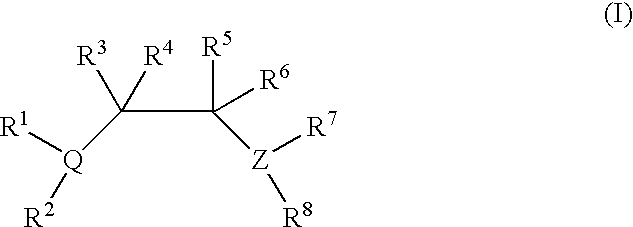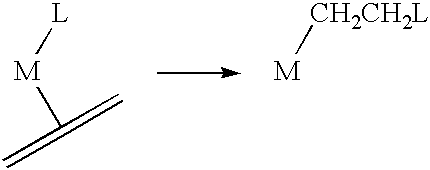Polymerization of olefinic compounds
a technology of olefinic compounds and compounds, applied in chemical/physical processes, group 3/13 element organic compounds, group 5/15 element organic compounds, etc., can solve problems such as polymerization
- Summary
- Abstract
- Description
- Claims
- Application Information
AI Technical Summary
Benefits of technology
Problems solved by technology
Method used
Image
Examples
example 2
Synthesis of Catalyst 1
In a drybox, 0.586 g (2.241 mmol) ligand L1, 0.303 g (1.120 mmol) nickel allyl chloride dimer, 1.986 g (2.241 mmol) sodium tetrakis(3,5-trifluoromethylphenyl)borate and 25 mL diethyl ether were mixed in a 100 mL RB flask. The resulting burgundy mixture was stirred at RT for 2 h. The mixture was then filtered through Celite.RTM., followed by 3.times.10 mL ether wash. The filtrate was evaporated under vacuum. The residue was dissolved in 3 mL dichloromethane, followed by addition of 30 mL pentane. Solvent was decanted. The procedure was repeated two more times by using 15 mL pentane. The resulting residue was dried under full vacuum. The brown solid was triturated with 20 mL pentane, filtered and washed with 3.times.10 mL pentane. The product was dried in vacuo for 2 h. Final weight of the brown solid was 2.475 g (90%). .sup.1 HNMR (in CD.sub.2 Cl.sub.2): .delta. 7.72 (s, 8H, Barf-H); 7.57 (s, 4H, Barf-H); 7.26-7.41 (m, 3H, Ar--H); 5.90 (heptet, 1H, central ally...
example 3
Synthesis of Ligand L2
In a 300 mL RB flask, 5.672 g (0.05 mol) methylpyruvate and 6.061 g (0.05 mol) 2,6-dimethylaniline were mixed with 150 mL toluene and 50 mg p-toluenesulfonic acid monohydrate. A Dean-Stark trap and a reflux condenser were attached to the flask. The amber solution was refluxed for 4 h, at which time ca. 0.9 mL H.sub.2 O had been collected. The solution was refluxed for an additional 3 h. Solvent was removed under vacuum. Amber oil was obtained. The oil was dissolved 100 mL hexanes and the solution was cooled at -40.degree. C. overnight. Solvent was decanted. The dark red oil was washed with 3.times.25 mL cold hexanes. The product was dried in vacuo for 2 h. Final weight of the dark red oil was 3.532 g (34%). .sup.1 HNMR (in CD.sub.2 Cl.sub.2): .delta. 6.90-7.10 (m, 3H, Ar--H); 3.91 (s, 3H, --OCH.sub.3); 1.97 [s, 6H, --C.sub.6 H.sub.3 (CH.sub.3).sub.2 ]; 1.89 (s, 3H, N.dbd.C--CH.sub.3).
example 4
Synthesis of Catalyst 2
In a drybox, 0.500 g (2.436 mmol) ligand L2, 0.329 g (1.218 mmol) nickel allyl chloride dimer, 2.159 g (2.436 mmol) sodium tetrakis(3,5-trifluoromethylphenyl)borate and 25 mL diethyl ether were mixed in a 100 mL RB flask. The mixture was stirred at RT for 2 h. It was then filtered through Celite.RTM., followed by 3.times.10 mL ether wash. The filtrate was evaporated under vacuum. The resulting brown solid was triturated with 20 mL pentane. The solid was filtered and washed with 3.times.10 mL pentane. The brown solid was dried in vacuo for 2 h. Final weight of the brown solid was 2.300 g (81%). .sup.1 HNMR (in CD.sub.2 Cl.sub.2): .delta. 7.73 (s, 8H, Barf-H); 7.57 (s, 4H, Barf-H); 6.90-7.30 (m, 3H, Ar--H); 5.91 (heptet, 1H, central allyl-H); 4.24 (s, 3H, --OCH.sub.3); 1.21, 2.55, 3.60 (bs, total 4H, terminal allyl-H); 2.21 [bs, 6H, --C.sub.6 H.sub.3 (CH.sub.3).sub.2 ]; 1.99 (s, 3H, N.dbd.C--CH.sub.3).
PUM
| Property | Measurement | Unit |
|---|---|---|
| pressure | aaaaa | aaaaa |
| temperature | aaaaa | aaaaa |
| temperature | aaaaa | aaaaa |
Abstract
Description
Claims
Application Information
 Login to View More
Login to View More - R&D
- Intellectual Property
- Life Sciences
- Materials
- Tech Scout
- Unparalleled Data Quality
- Higher Quality Content
- 60% Fewer Hallucinations
Browse by: Latest US Patents, China's latest patents, Technical Efficacy Thesaurus, Application Domain, Technology Topic, Popular Technical Reports.
© 2025 PatSnap. All rights reserved.Legal|Privacy policy|Modern Slavery Act Transparency Statement|Sitemap|About US| Contact US: help@patsnap.com



